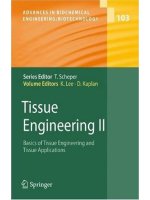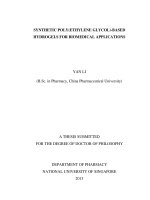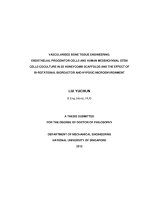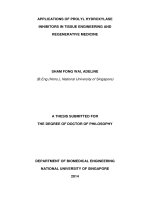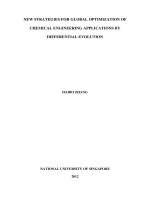Apatite based microcarriers for bone tissue engineering applications
Bạn đang xem bản rút gọn của tài liệu. Xem và tải ngay bản đầy đủ của tài liệu tại đây (10.5 MB, 139 trang )
!
!
APATITE BASED MICROCARRIERS FOR
BONE TISSUE ENGINEERING APPLICATIONS
!
FENG YONG YAO, JASON
NATIONAL UNIVERSITY OF SINGAPORE
2015
!
!
APATITE BASED MICROCARRIERS FOR
BONE TISSUE ENGINEERING APPLICATIONS
FENG YONG YAO, JASON
B.Eng.(Hons), National University of Singapore
A THESIS SUBMITTED FOR THE DEGREE OF
MASTER OF ENGINEERING
DEPARTMENT OF MECHANICAL ENGINEERING
NATIONAL UNIVERSITY OF SINGAPORE
2015
i!
!
Declaration
I hereby declare that this thesis is my original work and it has been written by
me in its entirety. I have duly acknowledged all the sources of information,
which have been used in the thesis.
This thesis has also not been submitted for any degree in any university
previously.
FENG YONG YAO, JASON
5 JANUARY, 2015
ii!
!
Abstract
The use of bioceramics, either alone or with other biomaterials has grown in
its various biomedical applications over the past 40 years. In the fields of
orthopaedics and dental surgery bioceramics have been extensively used as
biomaterials in prosthetic implants as well as bone graft substitutes. Recently,
the role of bioceramics has been featured in the field of regenerative medicine,
specifically in the niche of bone tissue engineering. Within this domain,
apatite based biomaterials can serve as substrates and scaffolds for bone
regeneration. One of the strategies proposed is the incorporation of in-vitro
cultured cells which are seeded on the scaffolds to create a more functional
tissue. However, the conventional method of culturing sufficient cells on the
scaffold can be inefficient and impractical. Use of microcarriers can overcome
these issues, but their applicability in bone tissue engineering has not been
considered.
The purpose of this report is to describe and evaluate the development of a
novel apatite based microcarrier. These microcarriers had been fabricated
using a unique drip casting method. In this method, 0.03 g/ml alginate
solutioni was mixed with 40 wt.% apatite, and the resultant solution was
extruded drop-wise through a drop-on-demand device into a 0.5M caclcium
chloride cross-linking solution. The apatite-alginate beads were then washed,
dried and subjected to a multi-stage sintering profile to 1150°C, to obtain the
apatite microcarriers. These microcarriers featured a substantially spherical
macromorphology of 200 – 300 µm, with a rough surface morphology and
open porous structure. Chemical characterisation confirmed a phase-pure
iii!
!
apatite composition without impurities. An in-vitro biological study was also
conducted to evaluate the microcarriers’ cytocompatibility as well as
osteogenic potency. Results demonstrated that the microcarriers were a highly
viable platform for in-vitro cell expansion, in which proliferation and viability
were significantly higher when compared with Cytodex
®
3. Expressions of
alkaline phosphatase (ALP), type I collagen (COL1) and osteocalcin (OC)
were significantly higher over monolayer tissue culture plate controls. A
preliminary in-vivo study was also conducted on a mouse model to assess
ectopic bone formation. Over a two-month period, immature bone formation
was observed, with indications of active bone remodelling.
In conclusion, these findings would suggest that the apatite microcarriers
possessed excellent biocompatibility for bone implant applications, and when
seeded with stem cells, produced osteo-regenerative properties. Ultimately,
this report aims to evaluate the apatite microcarriers as a viable biomaterial for
bone tissue engineering, intended as a single-step cell expansion and in-situ
osteogenic differentiation platform to be implemented as a non-invasive,
injectable bone graft substitute for the repair and regeneration of bone defects.
iv!
!
Acknowledgements
I would like to express my sincere appreciation to A/Prof Dr Thian Eng San,
Dr. Jerry Chan, and Dr. Wilson Wang for their invaluable guidance, support,
advice and assistance to this project.
I would like to thank Dr. Mark Chong and Dr. Zhang Zhiyong for their
supervision and assistance throughout the whole project and answering of all
the queries.
I would like to also thank Dr. Lim Poon Nian for her assistance in carrying
out the synthesis and characterisation successfully and other various assistance
given.
Lastly, I would like to thank everyone that has helped me out in any other
ways throughout the whole study.
!
!
!
!
!
!
!
!
!
!
!
!
v!
!
Publications, Conferences and Awards
Journals:
1) Feng J, Chong M, Chan J, Zhang ZY, Teoh SH, Thian ES. A scalable
approach to obtain mesenchymal stem cells with osteogenic potency on
apatite microcarriers. Journal of Biomaterials Applications. 2013, 29:93-
103
2) Feng J, Thian ES. Applications of nanobioceramics to healthcare
technology. Nanotechnology Reviews. 2013, 2:679-97.
Conferences Proceedings:
1) Feng J, Chong M, Chan J, Zhang ZY, Teoh SH, Thian ES. Fabrication,
Characterization and In-Vitro Evaluation of Apatite-Based Microbeads.
Ceramic Transactions 247. 2014
2) Feng J, Chong M, Chan J, Zhang ZY, Teoh SH, Thian ES. Apatite-based
microcarriers for bone tissue engineering. Key Engineering Materials 529-
530. 2013
Conferences (Oral):
1) Feng J, Chong M, Chan J, Zhang ZY, Teoh SH, Thian ES. Cell-loaded
ceramic based microbeads for direct bone implant science. 10
th
Pacific
Rim Conference on Ceramic and Glass Technology, San Diego, USA, 2
nd
June 2013 – 7
th
June 2013
2) Thian ES, Feng J, Chong M, Chan J, Zhang ZY, Teoh SH. Apatite-based
microcarriers for bone tissue engineering. 24
th
International Symposium on
Ceramics in Medicine, Fukuoka, Japan, 21
st
October – 24
th
October 2012
Conferences (Poster):
1) Thian ES, Feng J, Chong M, Chan J, Zhang ZY, Teoh SH. Apatite
microbeads as a means for stem cell expansion, 3
rd
Tissue Engineering and
Regenerative Medicine World Congress, Vienna, Austria, 5
th
September –
8
th
September 2012
2) Feng J, Chong M, Chan J, Zhang ZY, Teoh SH, Thian ES. Apatite
microcarriers as a potential bone tissue engineering solution. 1
st
International Conference of Young Researchers on Advanced Materials,
Singapore, 1
st
July – 6
th
July 2012
Awards
1) Best Poster Presenter Award (First Runner-Up) at the 1
st
International
Conference of Young Researchers on Advanced Materials, Singapore, 1
st
July – 6
th
July 2012
i!
!
Ta b l e o f C o n t e n t s
DECLARATION I!
ABSTRACT II!
ACKNOWLEDGEMENTS IV!
PUBLICATIONS, CONFERENCES AND AWARDS V!
TABLE OF CONTENTS I!
LISTS OF FIGURES IV!
LISTS OF TABLES VIII!
LISTS OF SYMBOLS IX!
CHAPTER 1 INTRODUCTION!
1.1! Background 1!
1.2! Objectives 4!
1.3! Scope 5!
CHAPTER 2 LITERATURE REVIEW!
2.1! Bone biology 7!
2.1.1! Physicochemical!characteristics!of!bone! !7!
2.1.2! Fracture!healing!mechanism! !11!
2.1.3! Stress!shielding!and!bone!mechanotransduction! !19!
2.1.4! Cellular!Response ! !22!
2.2! Bone Tissue Engineering 23!
2.2.1! Biocompatibility! !25!
2.2.2! Design!considerations:!Mechanical!properties,!degradation!
profile,!surface!char a c te r is t ic s ,!p o r o s it y !a n d !pore!siz e! !29!
2.2.3! Bioceramics! !36!
2.2.4! Hydroxyapatite! !37!
2.3! Fabrication of spherical bioceramic particles 44!
2.3.1! Alginate!as!a!matrix!polymer!for!microencapsulation! !44!
2.3.2! Microsphere!Preparation! !47!
CHAPTER 3 FABRICATION AND CHARACTERISATION OF
APATITE MICROCARRIERS
3.1! Introduction 49!
3.2! Materials and Methods 50!
ii!
!
3.2.1! Synthesis!of!phaseLpure!HA! !50!
3.2.2! Synthesis!of!apatite!microcarriers! !51!
3.2.3! Characterisation!of!apatite!microcarriers! !54!
3.3! Results 56!
3.3.1! PreLsintered!HALAlg!microcarriers! !56!
3.3.2! Thermal!analysis! !58!
3.3.3! Sintered!apatite!microcarriers! !60!
3.3.4! XRD!analysis! !61!
3.3.5! FTIR!analysis! !62!
3.4! Discussion 64!
3.5! Summary 67!
CHAPTER 4!IN-VITRO EVALUATION OF APATITE
MICROCARRIERS!
4.1! Introduction 68!
4.2! Materials and methods 69!
4.2.1! hfMSC!isolation! !69!
4.2.2! Cytocompatibility!study! !70!
4.2.3! Osteogenic!differentiation!study! !71!
4.2.4! Statistical!analysis! !73!
4.3! Results 74!
4.3.1! Proliferation!and!viability!of!hfMSCs! !74!
4.3.2! Osteogenic!potency!of!hfMSCs! !76!
4.4! Discussion 78!
4.5! Summary 83!
CHAPTER 5!IN-VIVO EVALUATION OF SUBCUTANEOUSLY
IMPLANTED APATITE MICROCARRIERS!
5.1! Introduction 84!
5.2! Materials and methods 86!
5.2.1! Samples,!animals!and!ethics! !86!
5.2.2! Isolation!and!ch ara cter isation !of!hfM S Cs ! !87!
5.2.3! Microcarrier!Culture! !87!
5.2.4! In#vivo!imp la n ta tio n !an d !ec to p ic !bo n e !for m a tio n ! !88!
5.2.5! Sample!preparation! !90!
5.2.6! Histological!analysis! !90!
5.2.7! Immun oh istolo gica l!ana lysis ! !91!
5.2.8! Statistics!…! !92!
5.3! Results 92!
iii!
!
5.3.1! Haematoxylin!and!eosin!study! !92!
5.3.2! Masson’s!trichrome!study! !94!
5.3.3! Von!Kossa!study! !95!
5.3.4! Osteopontin!and!osteonectin!expression! !96!
5.4! Discussion 99!
5.5! Summary 104!
CHAPTER 6!CONCLUSIONS 106!
CHAPTER 7!FUTURE WORK!
7.1! Use of substituted apatite in the fabrication of microcarriers 108!
7.2! Use of apatite microcarriers in dynamic bioreactors 108!
7.3! In-vivo evaluation of the healing of bone defects in medium to large sized
animal models 109!
REFERENCES 110!
!
iv!
!
Lists of Figures
Figure 2.1.
Hierarchical nature of bone[11].
7
Figure 2.2.
A schematic diagram illustrating the assembly of collagen
fibrils and fibres and bone mineral crystals. The well
known 67 nm periodic pattern results from the presence of
adjacent hole (40 nm) and overlap (27 nm) regions of the
assembled molecules[11].
9
Figure 2.3.
The fracture healing process. The fracture hematoma (A) is
transformed into granulation tissue first, followed by
migration and differentiation of MSCs and fibroblasts into
osteoblasts and chondrocytes respectively (B).
Mineralisation of the callus occurs, forming woven bone
(C). Restoration of the cylindrical shape occurs through
remodelling of the bony callus to lamellar bone (D)[15]
12
Figure 2.4.
Sequence of events following fracture in a rat model. a)
Fracture healing can be divided into three overlapping
phases: inflammation, repair and remodelling. b) IFM
varies over the course of fracture healing. c) Blood flow is
represented as percentage change from pre-fracture levels.
d) Tissue composition varies throughout fracture repair.
Abbreviations: IFM, interfragmentary movement[19].
16
Figure 2.5.
Ashby map illustrating the comparison of Young’s
modulus (Stiffness) to strength of various biomaterials.
Note that stiffness and strength of metals and their alloys
are generally several orders of magnitude higher than that
of other materials and biological tissue[59].
30
Figure 2.6.
X-ray diffraction profiles: (A) enamel (a), dentine (b) and
bone (c) mineral (carbonate apatites) (B) ceramic HA (a),
bone (b). (C) FTIR spectra of ceramic HA (a) and bone
mineral.[82]
38
Figure 2.7.
Mechanism model of hydrothermal convection of calcite
crystals into HAp crystals[83]
40
Figure 2.11.
SEM microgragh of (a) as-precipitated HA and (b) after the
aging process (100,000x)[85]
43
Figure 2.12.
XRD pattern of synthesised hydroxyapatite as precipitated
(a), heating at 850°C (b) 1200°C (c). Peaks of
hydroxyapatite (JCSPDS 9-432)
44
Figure 2.13.
The monomers of Alginate[86]
44
v!
!
Figure 2.14.
Three basic blocks of Alginate polymer chains, the MM-
block (left), GM-block (middle), and GG-block (right),
which may join together in different proportions,
distribution and length.[88]
45
Figure 2.15.
(a) Viscosity as a function of Concentration of Alginate in
Water. (b) Viscosity as a function of Temperature. Low
viscosity: 80 DP alginate, medium viscosity: 400 DP
alginate, and high viscosity: 680 DP alginate.[89]
45
Figure 2.16.
Calcium binding site in G-blocks[90]
46
Figure 2.17.
Egg-box model of Alginate gel formation[90]
47
Figure 3.1.
Synthesis process of apatite microcarriers. Apatite powder
is dispersed in an alginate solution and mixed to ensure
thorough homogenisation. The Apatite-Alginate solution is
then extruded drop-wise through an electrically controlled
valve that ensures consistent size into a calcium chloride
cross-linking solution. The resulting microbeads are then
washed, dried, and subjected to a multiple-staged sintering
process to 1150°C. Alginate serves as the matrix to
structure nano-crystalline apatite into a microsphere, and
also allows the formation of pores when it is burnt off
52
Figure 3.2.
4-stage sintering profile for HA-Alg microcarriers
53
Figure 3.3.
SEM micrograph of crushed pre-sintered HA-Alg
microcarrier (50 wt.% HA, 0.03 g/ml Alg) to show internal
morphology
57
Figure 3.4.
Pre-sintered HA-Alg microcarriers fabricated using (a) 0.1
M and (b) 0.5 M CaCl
2
crosslinking solution
58
Figure 3.5.
Thermal analyses of HA-Alg microcarriers (40 wt.% HA,
0.03 g/ml Alg). (a) TGA graph, and (b) DTA graph
60
Figure 3.6.
Sintered apatite microcarrier (40 wt.% HA, 0.03 g/ml Alg).
(a) Normal view, and (b) Cross-sectional view
60
Figure 3.7.
XRD patterns of (a) as-synthesised apatite powder and (b)
sintered apatite microcarriers. Asterisks indicate phases of
apatite
61
Figure 3.8.
FTIR spectra of (a) as-synthesised apatite powder and (b)
sintered apatite microcarriers. Bands of phosphate and
carbonate are labelled
63
vi!
!
Figure 4.1.
PrestoBlue proliferation assay of hfMSCs cultured on
Cytodex 3, apatite microcarriers and on conventional
monolayer culture (*p < 0.05, ***p < 0.001)
74
Figure 4.2.
CLSM images of hfMSCs cultured on the apatite
microcarriers at day 1, 3, 7 and 14. FDA/PI staining was
used. Live and dead cells were stained green and red,
respectively
75
Figure 4.3.
Phalloidin-DAPI staining of hfMSC loaded apatite
microcarriers. Actin filaments were stained red, and nuclei
stained blue. (a) Image showing extensive cell coverage
over the entire carrier. Actin filaments were aligned along
the curvature of the microcarrier, demonstrating good cell
adhesion characteristics. (b) Image of a 3-microcarrier
aggregate. Cells tended to form bridges across each other,
creating an interconnected network between microcarriers
76
Figure 4.4.
(a) ALP assay was performed on adherent monolayer
culture and apatite microcarriers. On day 12, ALP
expression for hfMSCs cultured on the apatite
microcarriers was 2.7-fold higher than that of the adherent
monolayer culture. (b) Collagen type I synthesis was
measured. hfMSCs cultured on the apatite microcarrier
produced greater amount of collagen type I throughout the
culture days. (c) Osteocalcin in BM was measured.
Osteocalcin expression was the highest for hfMSCs
cultured on apatite microcarriers. (*p < 0.05, **p < 0.01,
***p < 0.001). Osteocalcin for control (not shown) was
statistically insignificant (p > 0.05).
77
Figure 5.1.
Experimental time line for the in-vivo study of hfMSC-
loaded apatite microcarriers
88
Figure 5.2.
Haematoxylin and eosin staining of subcutaneously
implanted apatite microcarriers. Group 1 (Fibrin only),
Group 2 (Apatite microcarriers + fibrin) and Group 3
(hfMSC loaded apatite microcarriers + fibrin)
92
Figure 5.3.
High magnification H&E of (a) apatite microcarriers +
fibrin and (b) hfMSC loaded apatite microcarriers + fibrin
at 2 months of implantation. Circle (dotted) indicates
capillary formation while arrow indicates osteoclast bone
remodelling.
93
Figure 5.4.
Masson’s trichrome staining of group 2 (apatite
microcarriers + fibrin) and group 3 (hfMSC-loaded apatite
microcarriers+ fibrin)
94
vii!
!
Figure 5.5.
Von Kossa staining of implanted apatite microcarriers
alone (group 2) and hfMSC-loaded (group 3). Black spots
indicate heavy mineralisation.
95
Figure 5.6.
Immunohistology of group 2 (apatite microcarriers +
fibrin) and group 3 (hfMSC loaded apatite microcarriers +
fibrin) tissue samples. Slides were stained for human
specific osteopontin (red) and counterstained with DAPI
(blue).
97
Figure 5.7.
Osteopontin coverage normalised to cell nuclei count (n =
5) at various time points. hfMSC-loaded apatite
microcarriers express 2.7-fold greater osteopontin
compared to the group containing apatite microcarriers
only(*p < 0.05, **p < 0.001).
97
Figure 5.8.
Immunohistology of human specific osteonectin (red) on
(a) apatite microcarriers only (Group 2) and (b) hfMSC-
loaded apatite microcarriers (Group 3), 1 month post-
implantation. Samples were counterstained with DAPI
(blue).
98
!
viii!
!
Lists of Tables
Table 2.1
Mechanical properties of cortical bone and trabecular
bone[13].
10
Table 2.2.
Elastic modulus of bone according to different levels of
organisation[14].
11
Table 2.3.
Summary of bone graft substitutes currently
available[54].
27
Table 2.4.
Percent increase in ALP and ECM calcium content for
osteoblasts cultured on nanoscale compared to
microscale bioceramics after 28 days[61]
32
Table 2.5.
List of calcium phosphate phases. Abbreviations:
calcium-deficient hydroxyapatite (CDHA), precipitated
HA (pHA). [71]
36
Table 3.1.
Apatite microcarriers fabricated using different Alg
concentrations, HA contents and CaCl2 concentrations
53
Table 3.2.
FTIR band assignments
63
!
!
!
ix!
!
Lists of Symbols
ACP
Amorphous calcium phosphate
Alg
Alginate
ALP
Alkaline phosphatase
ANOVA
Analysis of variance
BCP
Biphasic calcium phosphates
ANOVA
Analysis of variance
Ca
Calcium
COL 1
Type I Collagen
DI
Deionised
DMEM
Dulbecco’s modified Eagle medium
D10
Dulbecco’s modified Eagle medium
supplemented-GlutaMAX with
10 % foetal bovine serum and 1 %
penicillin-streptomycin
EDS
Energy dispersive x-ray
spectroscopy
ECM
Extracellular matrix
x!
!!
FDA
Fluorescein diacetate
FESEM
Field emission scanning electron
microscope
FTIR
Fourier transform infrared
spectroscope
HA
Hydroxyapatite
hfMSC
Human foetal mesenchymal stem
cell
OC
Osteocalcin
OP
Osteopontin
ON
Osteonectin
PBS
Phosphate buffered saline
PI
Propidium iodide
TCP
Tricalcium phosphate
TEM
Transmission electron microscope
XPS
X-ray photoelectron spectroscopy
XRD
X-ray diffraction
!
!
Chapter 1 Introduction
!
1!
!
CHAPTER 1
Introduction
1.1 Background
Bone is the a load bearing structure of all vertebrates. It is a composite
material comprising of mineral and organic phases organised in a complex
hierarchical structure, starting from the nanoscale up, and functions to serve
vital mechanical, anabolic and metabolic roles. Bone defects, injuries and
degeneration can occur either through trauma or disease, or a combination of
both. These conditions are frequently encountered in clinical practice and
while conventional methods exist to treat these conditions, complete bone
regeneration cannot be consistently assured, which can lead to complications
such as bone non-union and development of post-traumatic osteoarthritis.
Moreover, bone-related injuries and diseases may be chronic in nature, which
can certainly cause a considerable strain on healthcare resources due to the
long-term care required for treatment and rehabilitation. Furthermore, as the
population in Singapore (or even worldwide) continues to age, the prevalence
of osteoporosis among the elderly would make them more susceptible to bone
fractures.
Currently, the use of bone grafts, obtained from either autogenic or allogeneic
sources is the preferred strategy for healing of bone defects. Bone grafting
remains a major need in the global world, which can amount to a demand of
more than $2.5 billion a year[1]. In the United States alone, approximately
half of the 3 million musculoskeletal procedures performed annually require
Chapter 1 Introduction
!
2!
!
bone grafting with either an autograft or allograft[2]. Around the world, bone
grafting involving autografts and allografts account for nearly 2.2 million
orthopaedic procedures performed annually[3]. While the use of autografts is
considered as the gold standard for bone defect repairs, this is severely limited
by donor-site morbidity and availability[1, 4, 5]. In the case of allogeneic
grafts, challenges imposed include host compatibility, as well as risks of
disease transmission[5]. As a result, research and development of viable,
biocompatible, effective and efficacious bone graft substitutes continue to be
an area of intense interest.
Several synthetic scaffolds and bone filler biomaterials have been developed
to serve as substitutes for bone grafts, but these products vary in success. Bone
graft substitutes featuring macrometer-sized scaffolds such as
polycaprolactone (PCL) or collagen-based materials are currently available,
but these scaffolds may not possess the appropriate mechanical properties of
high compressive moduli and high fracture toughness. While the surfaces of
these materials can be functionalised with various biomolecules, incorporating
the correct microstructural properties (pore size, porosity, roughness,
hydrophobicity, etc.) remain highly complex and can be expensive and time-
consuming. Furthermore, these scaffolds may not conform well to the defect
site and offer limited flexibility in surgical manipulation, which poses a
problem in irregularly shaped defects. Bone filler materials that feature
ceramic granules such as coralline hydroxyapatite, calcium phosphate or
bioglass have been developed to serve as a less invasive flexible solution for
filling bone defects. Nevertheless, synthetic bone filler materials currently
Chapter 1 Introduction
!
3!
!
available lack deliberate design of morphology and surface characteristics,
which fully replicates the microenvironment of the natural bone. These
solutions remain inferior to their autogenic counterparts and do not sufficiently
improve healing rates and ensure long-term success.
It would be ideal if bone fractures can be repaired and healed, where
functionality of the bone tissues can be restored in a safe, consistent and rapid
manner by an off-the-shelf product that is cost-effective and easily
implemented by the orthopaedic surgeon. The concept of using stem cells
accomplishes this need, regenerating damaged bone tissues, while stimulating
the body’s own repair mechanisms to assist with the healing process. Stem
cells have garnered much attention in this regard since they have the ability to
differentiate while maintaining self-renewal. There are already extensive
clinical trials being conducted to proof its use, and the potential is highly
promising. However, one major obstacle in translating this technology from
bench to bedside is the sheer number of hfMSCs required for successful
transplantation. A dose of 3 - 5 x 10
7
cells/patient is needed to treat patients
with advanced multiple sclerosis [6]whilst 5.7 - 7.5 x 10
8
cells/kg is required
for the treatment of osteogenesis imperfecta [7]. The conventional technique
to achieve such cell numbers involves the expansion of cells on monolayer
tissue culture flasks. Given that a standard T175 flask is able to yield only 3.5
- 5 x 10
6
MSCs at confluence, considerable resources have to be spent on cell
medium, flasks and incubators, making such a method neither efficient nor
economically feasible. Furthermore, these cells have to undergo repeated
passaging which is considered to be labour intensive and time consuming, but
Chapter 1 Introduction
!
4!
!
more importantly, diminishes the capacity for MSCs to retain their stemness.
The repeated destruction of extra-cellular matrix (ECM) through multiple
trypsinisation is also likely to decrease intra-cellular signalling responsible for
cell viability, proliferation and differentiation[8]. To overcome this, the use of
microbeads has been proposed. This involves the use of micrometre-sized
spherical particles where cells are seeded upon, and allowed to proliferate
under gentle dynamic flow conditions. Microbeads have been developed for
such applications and cell yield up to 10
8
cells/ml can be achieved [9].
However, these microbeads are either polymer or glass based materials,
making them unsuitable as long-term bone graft substitutes.
1.2 Objectives
In order to overcome the above mentioned challenges, development of a tissue
engineered bone graft substitute, which aims to deliver a single-step, non-
invasive, injectable strategy, which incorporates the properties of
osteoinduction, osteoconduction and enhances osteogenicity is proposed. This
can be accomplished through the use of phase-pure porous apatite
microcarriers, which possess the appropriate physicochemical and
microstructural properties that enable for in-situ proliferation, differentiation
and in-vivo phenotypic maintenance of MSCs.
The specific objectives can be summarised as such:
• Develop suitable novel apatite-based porous microcarriers as cell
carriers.
Chapter 1 Introduction
!
5!
!
• Establish the apatite-based porous microcarriers as an efficient tool for
obtaining high yield mesenchymal stem cells (MSCs) isolation and
expansion in-vitro.
• Establish the apatite-based porous microcarriers as an efficient
platform for driving directed differentiation of MSCs into osteogenesis
in-vitro.
• Evaluate the efficacy of the MSC-loaded apatite-based porous
microcarriers to generate ectopic bone formation in-vivo.
1.3 Scope
Chapter 1 establishes the background and motivation of this dissertation,
which demonstrates the need for bone tissue engineering, and the development
of novel biomaterials. It is proposed that the use of phase-pure porous apatite
microcarriers will be a superior alternative over conventional monolayer
culture techniques. This is hypothesised to enhance bone regeneration when
used as a bone graft substitute. Chapter 2 summarises the relevant literature
regarding bone, bone tissue engineering and bioceramics, in which key design
considerations are highlighted in the development of a bone tissue engineered
biomaterial. Chapter 3 presents a detailed study on the fabrication of the
apatite microcarriers, which includes the characterisation of its
physicochemical properties, as well as optimisation of the various parameters
for the fabrication of an apatite microcarrier that is relevant for its intended
application. Chapter 4 details the evaluation of the apatite microcarriers in-
vitro, to assess its cytocompatibility and effects on the osteogenic potency on
mesenchymal stem cells, so as it establish its efficacy as a microcarrier for in-
Chapter 1 Introduction
!
6!
!
vitro cell culture. Chapter 5 further evaluates the apatite microcarriers as
implantable bone graft substitutes, through an in-vivo study on ectopic bone
formation in a mouse model. Properties of biocompatibility, osteogenicity and
neo-vascularisation are investigated. Chapter 6 gives an overall conclusion of
the present work. Chapter 7 provides an outlook of the possible future work
and development of the apatite microcarriers so as to increase its relevance
towards various dental and orthopaedic applications, and gain clinical
acceptance.
Chapter 2 Literature Review
7!
!
CHAPTER 2
Literature Review
2.1 Bone biology
In order to develop engineering considerations for the bone tissue engineered
construct, it is necessary to understand the biology of bone. The bone is the
major load-bearing organ of all vertebrates. In addition to providing
mechanical stability, it is vital in the process of haematopoiesis, and
functioning as the main repository for adult mesenchymal stem cells as well as
hematopoietic stem cells. Furthermore, it plays several metabolic functions
including mineral storage, growth factor storage, and maintaining acid-base
balance. Bone has also been implicated as fulfilling the endocrine role of
maintaining glucose and phosphate homeostasis by producing hormones such
as FGF23 and osteocalcin which influence phosphate disposal and glucose
utilisation respectively[10].
2.1.1 Physicochemical characteristics of bone
Figure 2.1. Hierarchical nature of bone[11].
Chapter 2 Literature Review
8!
!
Chemically, bone is composed of an organic phase consisting of mainly
collagen (35% dry weight) and a mineral phase of carbonated apatite (65% dry
weight). These phases are organised in a highly hierarchical structure (Figure
2.1). At the macroscale level, bone can be described an organ consisting of
two kinds of osseous tissue: cortical bone and trabecular bone. Cortical bone
covers the outer surface of the bone and is a dense and compact tissue, which
sustains major loading forces. It is thickest at the middle of the shaft and
becomes thinner at both ends of the bone. At the proximal and distal ends of
the bone, where cortical bone is the thinnest, bone transitions into a less dense
and more porous structure, or trabecular bone. This is to facilitate load transfer
during articulation[12]. Trabecular bone has an average density of 0.2 g/cm3
and porosity as high as 90%, with 1 mm spacing between the trabecular
columns. In comparison, cortical bone is much denser at 1.80 g/cm3, with a
porosity of 3-12% with no visible macropores. Microscopically, both cortical
and trabecular bone are made up of Haversian systems (osteons) which are
layers of compact bone stacked in concentric layers around a Haversian canal
which contains the bone’s blood vessels and nerves. These concentric layers,
or lamellae, have a nanoarchitechture consisting of bundles of collagen fibres
interspaced with apatite crystals[11]. These lamellae are stacked in an
alternating fibre orientation at 45° to the vertical axis. Collectively, the nano-,
micro-, and macro-scale architecture of bone is responsible for its unique
rigidity, viscoelasticity and toughness. In addition to contributing to its
mechanical properties, the microstructure of bone forms a unique
microenvironment for the bone cells. The four main mature cells that

